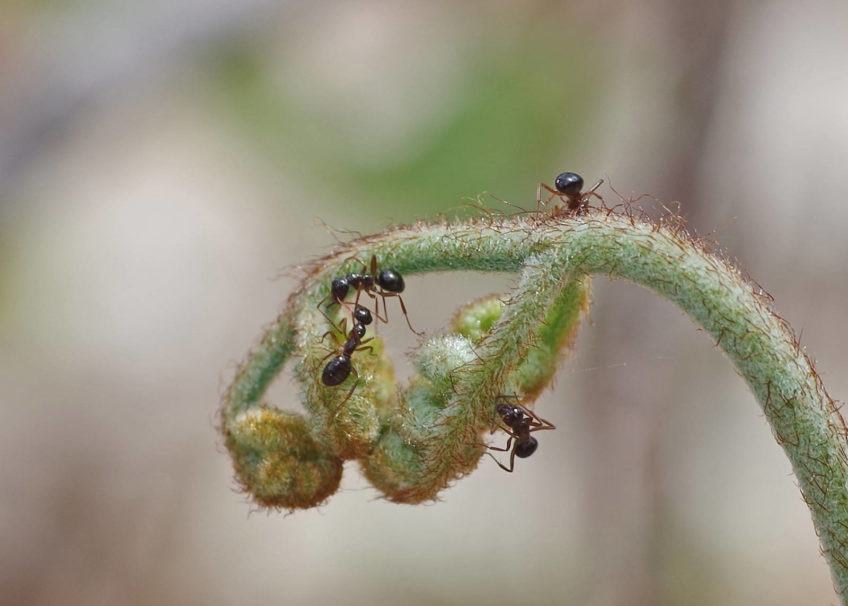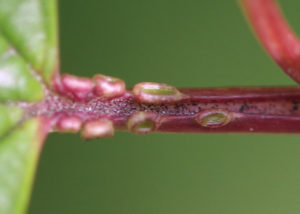
Ants in My Plants Rerun
Salutations, BugFans,
Here we are, in the trough between Christmas and New Year’s. The interminable Christmas movies have been put to bed (YAY!), and reruns rule. Here, too.
Back in 2015, the BugLady suspended operations during the month of May, posting a teaser at the start of her month off – a fern fiddlehead with an ant crawling on it. When she resumed her posts in June, she led with the story of that ant. Here it is:
The results of taking off the month of May are in: many pictures of plants, flowering and non; not so many pictures of insects, even though the BugLady was checking plants like wild geranium, dandelions, and autumn olive that put out masses of flowers. It’s a little worrisome. The nannyberry is hopping, though – sweat bees, small twitchy wasps, syrphid/hover/flower flies, an occasional honeybee, etc. And the first crop of dragonflies is emerging. The other bit of fallout was that with no Tuesday deadline to aim for, the BugLady was, for the most part, clueless about which day of the week it was. Adrift.
As promised, the story of the fern and the ant, a story that comes with a side order of botany.
It is hardly breaking news that plants produce nectar, a sugary liquid that the plant makes in nectaries that are located within the flowers. Along with sugars, nectar may include amino acids, oils, vitamins, proteins, and more. Why do they do it? To attract the moths, bees, wasps, butterflies, and even hummingbirds and bats that inadvertently fertilize plants by carrying pollen to the next flower they visit. “I feed you; you fertilize me.” After fertilization, a plant may reabsorb its nectar.

BUT – a fair number of plants produce nectar in places other than their flowers, and these areas, called Extrafloral nectaries (EFN), don’t have anything (directly) to do with pollination. EFN may be found on flower stalks, leaf axils, petioles, or leaf margins, or on various flower parts, and the nectar they provide is sweeter than the plant’s sap. Some EFN are conspicuous; others are not http://edis.ifas.ufl.edu/in175. Bracken ferns, which are non-flowering plants, have EFN at the bases of their three fronds as those fronds are just starting to unfurl.
Why do they do it? EFN were originally (and erroneously) thought to be a waste disposal system for the plant, allowing it to get rid of metabolic by-products. And while scientists are still not 100% sure why plants make EFN, they are probably there for ants and other predatory insects like ladybugs.
EFN could be decoys – “I feed you here, and you stay away from my flowers.” It turns out that ants, despite their notable presence on flowers, are seldom effective pollinators. Their exoskeletons are slick and are groomed frequently; they are pedestrians, which limits the number of flowers they can visit; and they don’t exhibit the “flower constancy” of bees, who will concentrate on a particular type of flower on a foraging trip, thus increasing the odds that the pollen they carry will be deposited on the correct species. Plus, an antibiotic secreted by some ants and found on their exoskeletons kills pollen. Ants do love nectar, though, and they may hog the nectar without delivering the payload and damage a flower in the process.
In the case of the bracken fern and its ants, it has always been assumed that EFN produce a reward for services rendered – an “I feed you; you protect me from herbivores” scenario – but here’s where it gets a bit sticky, scientifically. Studies that measure the degree of protection contradict each other. Researchers in the 1960’s described significant benefits to the fern foliage; recent studies suggest that while some grazers might be chased away in the early days as fronds are uncurling (when the plant produces the most sugar), there’s not a significant difference in foliage on ant vs ant-free ferns by the end of the season (when sugar secretion is very low).
Post-floral or pericarpial nectaries (PN) are much less common. Some plants continue to produce nectar around the base of the flower after the petals fall and throughout the development of the fruits. The foraging ants thus protect the seeds (or not, say some studies). Apparently, garlic mustard has this in its bag of tricks.
Besides protection, ants provide other services to plants. In exchange for food (and sometimes shelter – some plants have special structures where ants can live), foraging ants keep leaf surfaces clean, which helps keep plants fungus/disease-free. Ants may prune or thin vegetation, optimizing growing conditions and reducing competition, and they may assist with seed dispersal.
Ant-plant interactions enjoy a lovely vocabulary. A myrmecophile is an organism (usually an animal) that consorts with ants; myrmecophily (“ant-love”) refers to favorable relationships between ants and other organisms; and a myrmecophyte (“ant-plant”) is a plant that carries on mutually beneficial relationships with ants. Through a process called myrmecochory (ant-dispersal”), ants spread and plant many wildflower seeds (according to some sources, ants “plant” almost one-third of spring ephemerals in eastern North America. Bloodroot is one of them). Attached to the seeds is an ant-attracting “packet” called an elaiosome. After toting the seeds back to their nests, ants break off the elaiosome and eat it, leaving the seed to germinate.
There are close to 4,000 plants worldwide, in more than 100 plant families, in 745 genera, that grow EFN Thirty-nine are fern species. Familiar practitioners include vetches (Vicia), gourds (Cucurbita), wild cherry (Prunus), elderberry (Sambucus), locust (Robinia), willow (Salix), wild sunflower (Helianthus), milkweed (Asclepias), and peony. The BugLady found some on the petiole (leaf stem) of a high-bush cranberry. When she first posted this, “The World List of Plants with EFN” was temporarily off-line. It’s back http://www.extrafloralnectaries.org/.
Go outside – watch ants.
Kate Redmond, The BugLady
Bug of the Week archives:
http://uwm.edu/field-station/category/bug-of-the-week/
